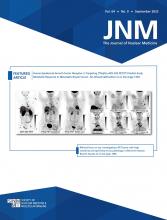This is the case of a 64-y-old man with metastatic castration-resistant prostate cancer treated with 5 cycles of 177Lu-prostate-specific membrane antigen (PSMA) radioligand therapy. After 2 cycles, prostate-specific antigen levels declined from 26.1 to 15.2 ng/mL (−42%) and interim PSMA PET/CT showed an overall favorable response with a decrease in whole-body PSMA tumor volume (1,430 cm3 to 124 cm3, −91%) and no new lesions (Fig. 1A). Of note, a liver lesion with high baseline PSMA expression (SUVmax, 28.0) showed a favorable response, with a decrease in size by CT (Fig. 1B), whereas PSMA-negative liver lesions (SUVmax, 5.8) progressed, with significant increases in size (Fig. 1C). His prostate-specific antigen level subsequently increased to 25 ng/mL after cycle 3, and he received 50 Gy delivered in 5 fractions of stereotactic body radiation therapy to the progressing liver lesions concomitantly with cycle 4, which led to a prostate-specific antigen nadir of 10.9 ng/mL. Unfortunately, his prostate-specific antigen level increased after cycle 5 (16.1 ng/mL) and the patient was switched to docetaxel and carboplatin. His overall survival was 24 mo after baseline PET/CT.
(A) 68Ga-PSMA-11 PET maximal-intensity-projection images at baseline and after 2 cycles of PSMA-RLT. (B) Segment 7 liver lesion with high baseline PSMA expression (SUVmax, 28.0) showed favorable response, with decrease in size by CT (36 × 24 mm to 20 × 16 mm, −63%). (C) Segment 4A and 7 liver lesions with no or low baseline PSMA expression (SUVmax, 5.8) progressed, with significant increases in size (32 × 23 mm to 62 × 62 mm, +422%, and 10 × 6 mm to 24 × 17 mm, +580%, respectively). RLT = radioligand therapy.
Low PSMA expression in prostate cancer cells can lead to low PSMA-targeted radiopharmaceutical uptake, insufficient radiation dose delivery and subsequent growth of PSMA-negative lesions (1). Here, we show different response patterns to PSMA radioligand therapy in liver lesions with varying levels of baseline PSMA expression. Parameters such as prostate-specific antigen or whole-body PSMA tumor volume can mask disease heterogeneity. Here, most of the disease responded positively to PSMA radioligand therapy whereas a few known lesions progressed. No conclusion can be made on whether PSMA radioligand therapy positively contributed to the overall survival of this patient, but one could speculate on whether exposure to PSMA radioligand therapy may promote the progression of aggressive PSMA-negative lesions. Further research is necessary to assess whether combining PSMA radioligand therapy with metastasis-directed therapy can improve PSMA-negative outcomes of patients with an overall high PSMA target expression and a limited number of PSMA-negative lesions.
DISCLOSURE
Dawn Owen reports research funding from AstraZeneca and Varian and an honorarium from UpToDate. Johannes Czernin is the founder of Sofie Biosciences. Jeremie Calais reports prior consulting services for Advanced Accelerator Applications, Blue Earth Diagnostics, Curium Pharma, EXINI, GE Healthcare, IBA RadioPharma, Janssen Pharmaceuticals, Lightpoint Medical, Lantheus, Monrol, Novartis, Progenics, POINT Biopharma, Radiomedix, and Telix Pharmaceuticals outside the submitted work. No other potential conflict of interest relevant to this article was reported.
Footnotes
Published online Jun. 15, 2023.
- © 2023 by the Society of Nuclear Medicine and Molecular Imaging.
REFERENCE
- 1.↵
- Received for publication November 2, 2022.
- Revision received February 10, 2023.








